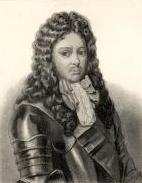Louis d'Aubusson de La Feuillade
Louis d'Aubusson, Comte de La Feuillade | |
|---|---|
 1702 Engraving of de La Feuillade | |
| Governor of La Dauphiné | |
| In office 1691–1719 | |
| Personal details | |
| Born | 30 March 1673 Marly-le-Roi, Île-de-France |
| Died | 29 January 1725 (aged 51) Marly-le-Roi, Île-de-France |
| Resting place | Couvent des Théatins, Paris |
| Spouse(s) | (1) Charlotte-Thérèse de la Vrilliere (1692-1697) (2) Marie Thérèse Chamillart (1701-1716) |
| Awards | Chevalier, Order of Saint Louis |
| Military service | |
| Allegiance | |
| Years of service | 1688–1706 |
| Rank | Marshal of France |
| Battles/wars |
|
Louis d'Aubusson de la Feuillade (30 March 1673 – 28 January 1725) was a French military officer and courtier who fought in the
Personal details
Louis d'Aubusson de la Feuillade, 7th duc de Roannais, was born on 30 March 1673, in

His mother, Charlotte de Gouffier, was sister and heir to Artus de Gouffier (1627-1696), 5th duke of Roannais and a close friend of writer, mathematician and Catholic theologian Blaise Pascal. Artus entered a monastery in 1667, assigning his titles and property to François de la Feuillade, in return for 400,000 livres and an agreement to marry Charlotte. Artus outlived his father and until his death in 1696, Louis d'Aubusson was known as 'leur-dit 7th duke of Roannais' or 'duke of La Feuillade.'[1]
He was married twice, first in 1692 to Charlotte-Thérèse de la Vrilliere (1675-1697), then in 1701 to Marie Thérèse Chamillart (1685-1716), daughter of Michel Chamillart, Minister for War. Both marriages were childless and the title of duke became extinct on his death in 1725.[1]
Career
In 1688, La Feuillade raised a cavalry regiment for the
A few years later, following the death in 1697 of his uncle, Georges de La Feuillade, Bishop of Metz, a review of the diocese financial records showed a large sum of money was missing. The report concluded La Feuillade had stolen it while visiting his uncle, and Louis XIV had to eb dissuaded from dismissng him from the army by Louis de Pontchartrain, a friend of his father-in-law.[5]

When the
As was customary, Turin's defences were divided into the outer 'City,' containing the residential and commercial areas, and the 'Citadel' at its core. La Feuillade and Vendôme proposed digging trenches around the City at a distance of 300–400 metres, then blasting the Citadel into submission, an approach known as the 'Coehoorn method', after the Dutch engineer,
The French position in Italy changed with their defeat at
With France's northern border under pressure after Ramillies, Louis XIV needed to end the war in Italy and in March 1707, he agreed the Convention of Milan with Emperor Joseph. To the fury of Joseph's allies, the French withdrew their remaining garrisons, ceding control of Milan and Mantua to Austria but in return were given free passage to France, allowing them to be redeployed in other theatres.[12]
Defeat at Turin ended de la Feuillade's active military career, although he was made Marshal of France in 1724. In 1719, his long-standing office of Governor of the Dauphiné was transferred to Duke of Orléans, and he rejected the post of Ambassador to the Vatican offered in its place.[13] He died in January 1725, and was buried in the Couvent des Théatins in Paris, demolished in 1825.[14] The title 'Duke of Roannais' died with de la Feuillade, but his other titles and lands passed to his cousin Jacques d'Aubusson.[15]
References
- ^ a b c Anselme & Du Forny 1750, p. 349.
- ^ "La Feuillade, Louis d'Aubusson". tombes-sepultures.com. Retrieved 20 December 2018.
- ^ Saint Simon 1879, p. 253.
- ^ Letter to M de Chateauneuf dated August 1693, National Archive reference G552
- ^ Chapman 2004, p. 29.
- ^ a b Lynn 1999, p. 309.
- ^ Czech 2006.
- ^ Falkner 2015, p. 67.
- ^ Symcox 1983, p. 150.
- ^ Duffy 1985, pp. 50–51.
- ^ Lynn 1999, p. 310.
- ^ Sundstrom 1992, p. 196.
- ^ Saint Simon 1879, p. 226.
- ^ "Couvent des Théatins". Weekisto. Retrieved 20 December 2018.
- ^ Moreri 1749, p. 20.
Sources
- Anselme, Augustin Dechauffé; Du Forny (1750). Histoire de la Maison Royale de France, et des grands officiers de la Couronne Volume V. Compagnie des Libraires.
- Duffy, Christopher (1985). The Fortress in the Age of Vauban and Frederick the Great 1660-1789 (2017 ed.). Routledge. ISBN 1138924644.
- Chapman, Sara (2004). Private Ambition and Political Alliances in Louis XIV's Government. University of Rochester Press. ISBN 1-58046-153-0.
- Czech, Kenneth P (2006). "War of the Spanish Succession; Battle of Turin". HistoryNet. Retrieved 23 March 2022.
- Falkner, James (2015). The War of the Spanish Succession 1701-1714. Pen and Sword. ISBN 978-1473872905.
- Lynn, John (1999). The Wars of Louis XIV 1667-1714. Longman. ISBN 0582056292.
- Moreri, Louis (1749). Le grand dictionnaire historique ou Le melange curieux de l'Histoire sacrée; Volume I. Libraires Associes, Paris.
- Saint Simon, Louis de Rouvray (1879). Boislisle, Arthur Andre (ed.). Memoires de Saint-Simon (in French). Hatchette et Cie, Paris.
- Sundstrom, Roy A (1992). Sidney Godolphin: Servant of the State. EDS Publications Ltd. ISBN 0874134382.
- Symcox, Geoffrey (1983). Victor Amadeus II: Absolutism in the Savoyard State, 1675-1730. University of California Press. ISBN 0520049748.
External links
- "Couvent des Théatins". Weekisto. Retrieved 20 December 2018.;
- "La Feuillade, Louis d'Aubusson". tombes-sepultures.com. Retrieved 20 December 2018.
